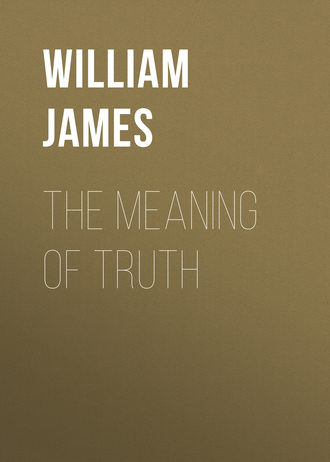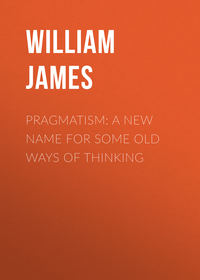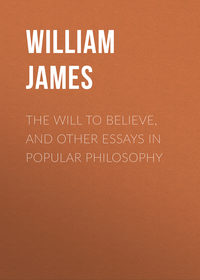 полная версия
полная версияThe Meaning of Truth
Before I can think you to mean my world, you must affect my world; before I can think you to mean much of it, you must affect much of it; and before I can be sure you mean it AS I DO, you must affect it JUST AS I SHOULD if I were in your place. Then I, your critic, will gladly believe that we are thinking, not only of the same reality, but that we are thinking it ALIKE, and thinking of much of its extent.
Without the practical effects of our neighbor's feelings on our own world, we should never suspect the existence of our neighbor's feelings at all, and of course should never find ourselves playing the critic as we do in this article. The constitution of nature is very peculiar. In the world of each of us are certain objects called human bodies, which move about and act on all the other objects there, and the occasions of their action are in the main what the occasions of our action would be, were they our bodies. They use words and gestures, which, if we used them, would have thoughts behind them,—no mere thoughts uberhaupt, however, but strictly determinate thoughts. I think you have the notion of fire in general, because I see you act towards this fire in my room just as I act towards it,—poke it and present your person towards it, and so forth. But that binds me to believe that if you feel 'fire' at all, THIS is the fire you feel. As a matter of fact, whenever we constitute ourselves into psychological critics, it is not by dint of discovering which reality a feeling 'resembles' that we find out which reality it means. We become first aware of which one it means, and then we suppose that to be the one it resembles. We see each other looking at the same objects, pointing to them and turning them over in various ways, and thereupon we hope and trust that all of our several feelings resemble the reality and each other. But this is a thing of which we are never theoretically sure. Still, it would practically be a case of grubelsucht, if a ruffian were assaulting and drubbing my body, to spend much time in subtle speculation either as to whether his vision of my body resembled mine, or as to whether the body he really MEANT to insult were not some body in his mind's eye, altogether other from my own. The practical point of view brushes such metaphysical cobwebs away. If what he have in mind be not MY body, why call we it a body at all? His mind is inferred by me as a term, to whose existence we trace the things that happen. The inference is quite void if the term, once inferred, be separated from its connection with the body that made me infer it, and connected with another that is not mine at all. No matter for the metaphysical puzzle of how our two minds, the ruffian's and mine, can mean the same body. Men who see each other's bodies sharing the same space, treading the same earth, splashing the same water, making the same air resonant, and pursuing the same game and eating out of the same dish, will never practically believe in a pluralism of solipsistic worlds.
Where, however, the actions of one mind seem to take no effect in the world of the other, the case is different. This is what happens in poetry and fiction. Every one knows Ivanhoe, for example; but so long as we stick to the story pure and simple without regard to the facts of its production, few would hesitate to admit that there are as many different Ivanhoes as there are different minds cognizant of the story. [Footnote: That is, there is no REAL 'Ivanhoe,' not even the one in Sir Walter Scott's mind as he was writing the story. That one is only the FIRST one of the Ivanhoe-solipsisms. It is quite true we can make it the real Ivanhoe if we like, and then say that the other Ivanhoes know it or do not know it, according as they refer to and resemble it or no. This is done by bringing in Sir Walter Scott himself as the author of the real Ivanhoe, and so making a complex object of both. This object, however, is not a story pure and simple. It has dynamic relations with the world common to the experience of all the readers. Sir Walter Scott's Ivanhoe got itself printed in volumes which we all can handle, and to any one of which we can refer to see which of our versions be the true one, i.e., the original one of Scott himself. We can see the manuscript; in short we can get back to the Ivanhoe in Scott's mind by many an avenue and channel of this real world of our experience,—a thing we can by no means do with either the Ivanhoe or the Rebecca, either the Templar or the Isaac of York, of the story taken simply as such, and detached from the conditions of its production. Everywhere, then, we have the same test: can we pass continuously from two objects in two minds to a third object which seems to be in BOTH minds, because each mind feels every modification imprinted on it by the other? If so, the first two objects named are derivatives, to say the least, from the same third object, and may be held, if they resemble each other, to refer to one and the same reality.] The fact that all these Ivanhoes RESEMBLE each other does not prove the contrary. But if an alteration invented by one man in his version were to reverberate immediately through all the other versions, and produce changes therein, we should then easily agree that all these thinkers were thinking the SAME Ivanhoe, and that, fiction or no fiction, it formed a little world common to them all.
Having reached this point, we may take up our thesis and improve it again. Still calling the reality by the name of q and letting the critic's feeling vouch for it, we can say that any other feeling will be held cognizant of q, provided it both resemble q, and refer to q, as shown by its either modifying q directly, or modifying some other reality, p or r, which the critic knows to be continuous with q. Or more shortly, thus: THE FEELING OF q KNOWS WHATEVER REALITY IT RESEMBLES, AND EITHER DIRECTLY OR INDIRECTLY OPERATES ON. If it resemble without operating, it is a dream; if it operate without resembling, it is an error. [Footnote: Among such errors are those cases in which our feeling operates on a reality which it does partially resemble, and yet does not intend: as for instance, when I take up your umbrella, meaning to take my own. I cannot be said here either to know your umbrella, or my own, which latter my feeling more completely resembles. I am mistaking them both, misrepresenting their context, etc.
We have spoken in the text as if the critic were necessarily one mind, and the feeling criticised another. But the criticised feeling and its critic may be earlier and later feelings of the same mind, and here it might seem that we could dispense with the notion of operating, to prove that critic and criticised are referring to and meaning to represent the SAME. We think we see our past feelings directly, and know what they refer to without appeal. At the worst, we can always fix the intention of our present feeling and MAKE it refer to the same reality to which any one of our past feelings may have referred. So we need no 'operating' here, to make sure that the feeling and its critic mean the same real q. Well, all the better if this is so! We have covered the more complex and difficult case in our text, and we may let this easier one go. The main thing at present is to stick to practical psychology, and ignore metaphysical difficulties.
One more remark. Our formula contains, it will be observed, nothing to correspond to the great principle of cognition laid down by Professor Ferrier in his Institutes of Metaphysic and apparently adopted by all the followers of Fichte, the principle, namely, that for knowledge to be constituted there must be knowledge of the knowing mind along with whatever else is known: not q, as we have supposed, but q PLUS MYSELF, must be the least I can know. It is certain that the common sense of mankind never dreams of using any such principle when it tries to discriminate between conscious states that are knowledge and conscious states that are not. So that Ferrier's principle, if it have any relevancy at all, must have relevancy to the metaphysical possibility of consciousness at large, and not to the practically recognized constitution of cognitive consciousness. We may therefore pass it by without further notice here.] It is to be feared that the reader may consider this formula rather insignificant and obvious, and hardly worth the labor of so many pages, especially when he considers that the only cases to which it applies are percepts, and that the whole field of symbolic or conceptual thinking seems to elude its grasp. Where the reality is either a material thing or act, or a state of the critic's consciousness, I may both mirror it in my mind and operate upon it—in the latter case indirectly, of course—as soon as I perceive it. But there are many cognitions, universally allowed to be such, which neither mirror nor operate on their realities.
In the whole field of symbolic thought we are universally held both to intend, to speak of, and to reach conclusions about—to know in short—particular realities, without having in our subjective consciousness any mind-stuff that resembles them even in a remote degree. We are instructed about them by language which awakens no consciousness beyond its sound; and we know WHICH realities they are by the faintest and most fragmentary glimpse of some remote context they may have and by no direct imagination of themselves. As minds may differ here, let me speak in the first person. I am sure that my own current thinking has WORDS for its almost exclusive subjective material, words which are made intelligible by being referred to some reality that lies beyond the horizon of direct consciousness, and of which I am only aware as of a terminal MORE existing in a certain direction, to which the words might lead but do not lead yet. The SUBJECT, or TOPIC, of the words is usually something towards which I mentally seem to pitch them in a backward way, almost as I might jerk my thumb over my shoulder to point at something, without looking round, if I were only entirely sure that it was there. The UPSHOT, or CONCLUSION, of the words is something towards which I seem to incline my head forwards, as if giving assent to its existence, tho all my mind's eye catches sight of may be some tatter of an image connected with it, which tatter, however, if only endued with the feeling of familiarity and reality, makes me feel that the whole to which it belongs is rational and real, and fit to be let pass.
Here then is cognitive consciousness on a large scale, and yet what it knows, it hardly resembles in the least degree. The formula last laid down for our thesis must therefore be made more complete. We may now express it thus: A PERCEPT KNOWS WHATEVER REALITY IT DIRECTLY OR INDIRECTLY OPERATES ON AND RESEMBLES; ACONCEPTUAL FEELING, OR THOUGHT KNOWS A REALITY, WHENEVER IT ACTUALLY OR POTENTIALLY TERMINATES IN A PERCEPT THAT OPERATES ON, OR RESEMBLES THAT REALITY, OR IS OTHERWISE CONNECTED WITH IT OR WITH ITS CONTEXT. The latter percept may be either sensation or sensorial idea; and when I say the thought must TERMINATE in such a percept, I mean that it must ultimately be capable of leading up thereto,—by the way of practical [missing section] is an incomplete 'thought about' that reality, that reality is its 'topic,' etc. experience, if the terminal feeling be a sensation; by the way of logical or habitual suggestion, if it be only an image in the mind.
Let an illustration make this plainer. I open the first book I take up, and read the first sentence that meets my eye: 'Newton saw the handiwork of God in the heavens as plainly as Paley in the animal kingdom.' I immediately look back and try to analyze the subjective state in which I rapidly apprehended this sentence as I read it. In the first place there was an obvious feeling that the sentence was intelligible and rational and related to the world of realities. There was also a sense of agreement or harmony between 'Newton,' 'Paley,' and 'God.' There was no apparent image connected with the words 'heavens,' or 'handiwork,' or 'God'; they were words merely. With 'animal kingdom' I think there was the faintest consciousness (it may possibly have been an image of the steps) of the Museum of Zoology in the town of Cambridge where I write. With 'Paley' there was an equally faint consciousness of a small dark leather book; and with 'Newton' a pretty distinct vision of the right-hand lower corner of curling periwig. This is all the mind-stuff I can discover in my first consciousness of the meaning of this sentence, and I am afraid that even not all of this would have been present had I come upon the sentence in a genuine reading of the book, and not picked it out for an experiment. And yet my consciousness was truly cognitive. The sentence is 'about realities' which my psychological critic—for we must not forget him—acknowledges to be such, even as he acknowledges my distinct feeling that they ARE realities, and my acquiescence in the general rightness of what I read of them, to be true knowledge on my part.
Now what justifies my critic in being as lenient as this? This singularly inadequate consciousness of mine, made up of symbols that neither resemble nor affect the realities they stand for,—how can he be sure it is cognizant of the very realities he has himself in mind?
He is sure because in countless like cases he has seen such inadequate and symbolic thoughts, by developing themselves, terminate in percepts that practically modified and presumably resembled his own. By 'developing' themselves is meant obeying their tendencies, following up the suggestions nascently present in them, working in the direction in which they seem to point, clearing up the penumbra, making distinct the halo, unravelling the fringe, which is part of their composition, and in the midst of which their more substantive kernel of subjective content seems consciously to lie. Thus I may develop my thought in the Paley direction by procuring the brown leather volume and bringing the passages about the animal kingdom before the critic's eyes. I may satisfy him that the words mean for me just what they mean for him, by showing him IN CONCRETO the very animals and their arrangements, of which the pages treat. I may get Newton's works and portraits; or if I follow the line of suggestion of the wig, I may smother my critic in seventeenth-century matters pertaining to Newton's environment, to show that the word 'Newton' has the same LOCUS and relations in both our minds. Finally I may, by act and word, persuade him that what I mean by God and the heavens and the analogy of the handiworks, is just what he means also.
My demonstration in the last resort is to his SENSES. My thought makes me act on his senses much as he might himself act on them, were he pursuing the consequences of a perception of his own. Practically then MY thought terminates in HIS realities. He willingly supposes it, therefore, to be OF them, and inwardly to RESEMBLE what his own thought would be, were it of the same symbolic sort as mine. And the pivot and fulcrum and support of his mental persuasion, is the sensible operation which my thought leads me, or may lead, to effect—the bringing of Paley's book, of Newton's portrait, etc., before his very eyes.
In the last analysis, then, we believe that we all know and think about and talk about the same world, because WE BELIEVE OUR PERCEPTS ARE POSSESSED BY US IN COMMON. And we believe this because the percepts of each one of us seem to be changed in consequence of changes in the percepts of someone else. What I am for you is in the first instance a percept of your own. Unexpectedly, however, I open and show you a book, uttering certain sounds the while. These acts are also your percepts, but they so resemble acts of yours with feelings prompting them, that you cannot doubt I have the feelings too, or that the book is one book felt in both our worlds. That it is felt in the same way, that my feelings of it resemble yours, is something of which we never can be sure, but which we assume as the simplest hypothesis that meets the case. As a matter of fact, we never ARE sure of it, and, as ERKENNTNISSTHEORETIKER, we can only say that of feelings that should NOT resemble each other, both could not know the same thing at the same time in the same way. [Footnote: Though both might terminate in the same thing and be incomplete thoughts 'about' it.] If each holds to its own percept as the reality, it is bound to say of the other percept, that, though it may INTEND that reality, and prove this by working change upon it, yet, if it do not resemble it, it is all false and wrong. [Footnote: The difference between Idealism and Realism is immaterial here. What is said in the text is consistent with either theory. A law by which my percept shall change yours directly is no more mysterious than a law by which it shall first change a physical reality, and then the reality change yours. In either case you and I seem knit into a continuous world, and not to form a pair of solipsisms.]
If this be so of percepts, how much more so of higher modes of thought! Even in the sphere of sensation individuals are probably different enough. Comparative study of the simplest conceptual elements seems to show a wider divergence still. And when it comes to general theories and emotional attitudes towards life, it is indeed time to say with Thackeray, 'My friend, two different universes walk about under your hat and under mine.'
What can save us at all and prevent us from flying asunder into a chaos of mutually repellent solipsisms? Through what can our several minds commune? Through nothing but the mutual resemblance of those of our perceptual feelings which have this power of modifying one another, WHICH ARE MERE DUMB KNOWLEDGES-OF-ACQUAINTANCE, and which must also resemble their realities or not know them aright at all. In such pieces of knowledge-of-acquaintance all our knowledge-about must end, and carry a sense of this possible termination as part of its content. These percepts, these termini, these sensible things, these mere matters-of-acquaintance, are the only realities we ever directly know, and the whole history of our thought is the history of our substitution of one of them for another, and the reduction of the substitute to the status of a conceptual sign. Contemned though they be by some thinkers, these sensations are the mother-earth, the anchorage, the stable rock, the first and last limits, the terminus a quo and the terminus ad quem of the mind. To find such sensational termini should be our aim with all our higher thought. They end discussion; they destroy the false conceit of knowledge; and without them we are all at sea with each other's meaning. If two men act alike on a percept, they believe themselves to feel alike about it; if not, they may suspect they know it in differing ways. We can never be sure we understand each other till we are able to bring the matter to this test. [Footnote: 'There is no distinction of meaning so fine as to consist in anything but a possible difference of practice.... It appears, then, that the rule for attaining the [highest] grade of clearness of apprehension is as follows: Consider what effects, which might conceivably have practical bearings, we conceive the object of our conception to have. Then, our conception of these effects is the whole of our conception of the object.' Charles S. Peirce: 'How to make our Ideas clear,' in Popular Science Monthly, New York, January, 1878, p. 293.] This is why metaphysical discussions are so much like fighting with the air; they have no practical issue of a sensational kind. 'Scientific' theories, on the other hand, always terminate in definite percepts. You can deduce a possible sensation from your theory and, taking me into your laboratory, prove that your theory is true of my world by giving me the sensation then and there. Beautiful is the flight of conceptual reason through the upper air of truth. No wonder philosophers are dazzled by it still, and no wonder they look with some disdain at the low earth of feeling from which the goddess launched herself aloft. But woe to her if she return not home to its acquaintance; Nirgends haften dann die unsicheren Sohlen—every crazy wind will take her, and, like a fire-balloon at night, she will go out among the stars.
NOTE.—The reader will easily see how much of the account of the truth-function developed later in Pragmatism was already explicit in this earlier article, and how much came to be defined later. In this earlier article we find distinctly asserted:—
1. The reality, external to the true idea;
2. The critic, reader, or epistemologist, with his own belief, as warrant for this reality's existence;
3. The experienceable environment, as the vehicle or medium connecting knower with known, and yielding the cognitive RELATION;
4. The notion of POINTING, through this medium, to the reality, as one condition of our being said to know it;
5. That of RESEMBLING it, and eventually AFFECTING it, as determining the pointing to IT and not to something else.
6. The elimination of the 'epistemological gulf,' so that the whole truth-relation falls inside of the continuities of concrete experience, and is constituted of particular processes, varying with every object and subject, and susceptible of being described in detail.
The defects in this earlier account are:—
1. The possibly undue prominence given to resembling, which altho a fundamental function in knowing truly, is so often dispensed with;
2. The undue emphasis laid upon operating on the object itself, which in many cases is indeed decisive of that being what we refer to, but which is often lacking, or replaced by operations on other things related to the object.
3. The imperfect development of the generalized notion of the WORKABILITY of the feeling or idea as equivalent to that SATISFACTORY ADAPTATION to the particular reality, which constitutes the truth of the idea. It is this more generalized notion, as covering all such specifications as pointing, fitting, operating or resembling, that distinguishes the developed view of Dewey, Schiller, and myself.
4. The treatment, [earlier], of percepts as the only realm of reality. I now treat concepts as a co-ordinate realm.
The next paper represents a somewhat broader grasp of the topic on the writer's part.
II
THE TIGERS IN INDIA [Footnote: Extracts from a presidential address before the American Psychological Association, published in the Psychological Review, vol. ii, p. 105 (1895).]
THERE are two ways of knowing things, knowing them immediately or intuitively, and knowing them conceptually or representatively. Altho such things as the white paper before our eyes can be known intuitively, most of the things we know, the tigers now in India, for example, or the scholastic system of philosophy, are known only representatively or symbolically.
Suppose, to fix our ideas, that we take first a case of conceptual knowledge; and let it be our knowledge of the tigers in India, as we sit here. Exactly what do we MEAN by saying that we here know the tigers? What is the precise fact that the cognition so confidently claimed is KNOWN-AS, to use Shadworth Hodgson's inelegant but valuable form of words?
Most men would answer that what we mean by knowing the tigers is having them, however absent in body, become in some way present to our thought; or that our knowledge of them is known as presence of our thought to them. A great mystery is usually made of this peculiar presence in absence; and the scholastic philosophy, which is only common sense grown pedantic, would explain it as a peculiar kind of existence, called INTENTIONAL EXISTENCE of the tigers in our mind. At the very least, people would say that what we mean by knowing the tigers is mentally POINTING towards them as we sit here.
But now what do we mean by POINTING, in such a case as this? What is the pointing known-as, here?
To this question I shall have to give a very prosaic answer—one that traverses the pre-possessions not only of common sense and scholasticism, but also those of nearly all the epistemological writers whom I have ever read. The answer, made brief, is this: The pointing of our thought to the tigers is known simply and solely as a procession of mental associates and motor consequences that follow on the thought, and that would lead harmoniously, if followed out, into some ideal or real context, or even into the immediate presence, of the tigers. It is known as our rejection of a jaguar, if that beast were shown us as a tiger; as our assent to a genuine tiger if so shown. It is known as our ability to utter all sorts of propositions which don't contradict other propositions that are true of the real tigers. It is even known, if we take the tigers very seriously, as actions of ours which may terminate in directly intuited tigers, as they would if we took a voyage to India for the purpose of tiger-hunting and brought back a lot of skins of the striped rascals which we had laid low. In all this there is no self-transcendency in our mental images TAKEN BY THEMSELVES. They are one phenomenal fact; the tigers are another; and their pointing to the tigers is a perfectly commonplace intra-experiential relation, IF YOU ONCE GRANT A CONNECTING WORLD TO BE THERE. In short, the ideas and the tigers are in themselves as loose and separate, to use Hume's language, as any two things can be; and pointing means here an operation as external and adventitious as any that nature yields.[Footnote: A stone in one field may 'fit,' we say, a hole in another field. But the relation of 'fitting,' so long as no one carries the stone to the hole and drops it in, is only one name for the fact that such an act MAY happen. Similarly with the knowing of the tigers here and now. It is only an anticipatory name for a further associative and terminative process that MAY occur.]









